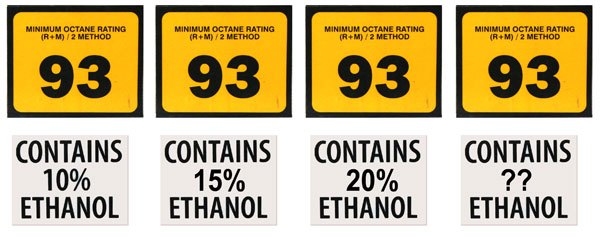#E15
EPA Approves E15 Ethanol Blends For 2007 And Later Model Years, Automakers, Blenders And Auto Advocates Protest
Bloomberg reports that the Environmental Protection Agency has approved blends of up to 15 percent ethanol in gasoline for cars produced since 2007, handing a victory to pro-ethanol groups like Growth Energy. The EPA had previously capped gas-ethanol blending at 10 percent (E10), on fears that the higher percentage of corn-based ethanol could damage engines. But the approval of E15 hasn’t exactly made those fears go away. According to Credit Suisse analyst Robert Moskow
The approval of E-15 by the EPA won’t have a positive effect on [ethanol giant Archer Daniels Midland] in the near-term. Blenders remain reluctant to implement E-15 because it requires a separate pump and because the EPA has not absolved the blenders of potential legal liability from consumers.
And it’s not just blenders who are up in arms at the decision. Gas refiner Valero Energy, the American Automobile Association and the Detroit automakers (which had previously been pro-ethanol) are all against the increase to E15 in “normal gas.” All of which means E15 isn’t likely to show up at your neighorhood gas pump anytime soon.
Ask The Best And Brightest: Would You Pay More For Ethanol-Free Fuel?
E15 Ethanol Opposition Calls For Congressional Hearings
Opposition to the Ethanol industry’s push to allow gasoline blends with up to 15 percent ethanol is coming together this week, as a massive coalition of interest groups calls for congressional hearings on the EPA’s pending E15 decision [via PRNewswire]. The Alliance of Automobile Manufacturers and Association of International Automobile Manufacturers joined 37 other groups, ranging from the National Resources Defense Council to the Outdoor Power Equipment and Engine Service Association, in calling on congressional energy committees to take up the issue.
EPA Resists Cheap BP Spill Symbolism, Delays Ethanol Blend Hike
America’s ethanol producers were some of the few Americans optimistic or cynical enough to find a bright side to the BP Gulf spill. Ethanol’s lobbyists-in-chief, GrowthEnergy, decided it would be real cute to run ads highlighting all the bad things ethanol hadn’t done. One of which is not “ Ethanol has never harmed the Gulf of Mexico,” by the way. As the ad parody above points out though, even if the ethanol was creating a dead zone in the Gulf of Mexico for years before the BP spill, there are quite a few other things ethanol hasn’t done. Like this, just in from the AP [via Google]: convince the EPA to buy into its shameful, manipulative PR line and rush a decision on increasing blending limits.
EPA Won't Rule On E15 Based On Two Cars Worth Of Data
Well, the good news is that the EPA has thus far refused to allow gasoline blends of more than ten percent ethanol. The bad news is that the Agency has yet to take a firm stand against the idea of eventually allowing E15 into the nation’s gas pumps. In fact, as the EPA’s response to the ethanol lobbying group Growth Energy’s request to allow E15 [ full document in PDF form here] opens:
It is vitally important that the country increase the use of renewable fuels. To meet that goal EPA is working to implement the long-term renewable fuels mandate of 36 billion gallons by 2022. To achieve the renewable fuel requirements in future years, it is clear that ethanol will need to be blended into gasoline at levels greater than the current limit of 10 percent.
E85 Boondoggle Of The Week: Blend Cap Decision Coming This Week
The EPA is set to rule as soon as tomorrow on the so-called “blend cap,” which forbids the sale of gasoline with more than ten percent ethanol. The petition to raise the blend cap came from a relatively new pro-ethanol lobbying group, Growth Energy, which requested the cap be moved to fifteen percent ethanol. Growth Energy’s request cites foreign oil dependence, “green-collar jobs” and the future of cellulosic ethanol as reasons to bump the blend cap, but as the New York Times reports, the real problem is that the ten percent limit is bumping up against a congressional mandate to blend 15b gallons of biofuels with gasoline by 2012. What the Times fails to mention is the financial incentive for raising the blend cap: the 51 cent-per-gallon of ethanol blended tax credit. In 2007, when gas consumption was at an all-time high and ethanol blending mandates required a mere 4.7b gallons (with 7b actually blended), that credit cost taxpayers nearly $3b. In 2012, when the mandate hits 15b gallons, the taxpayer tab will be closer to $7.65b.



















Recent Comments